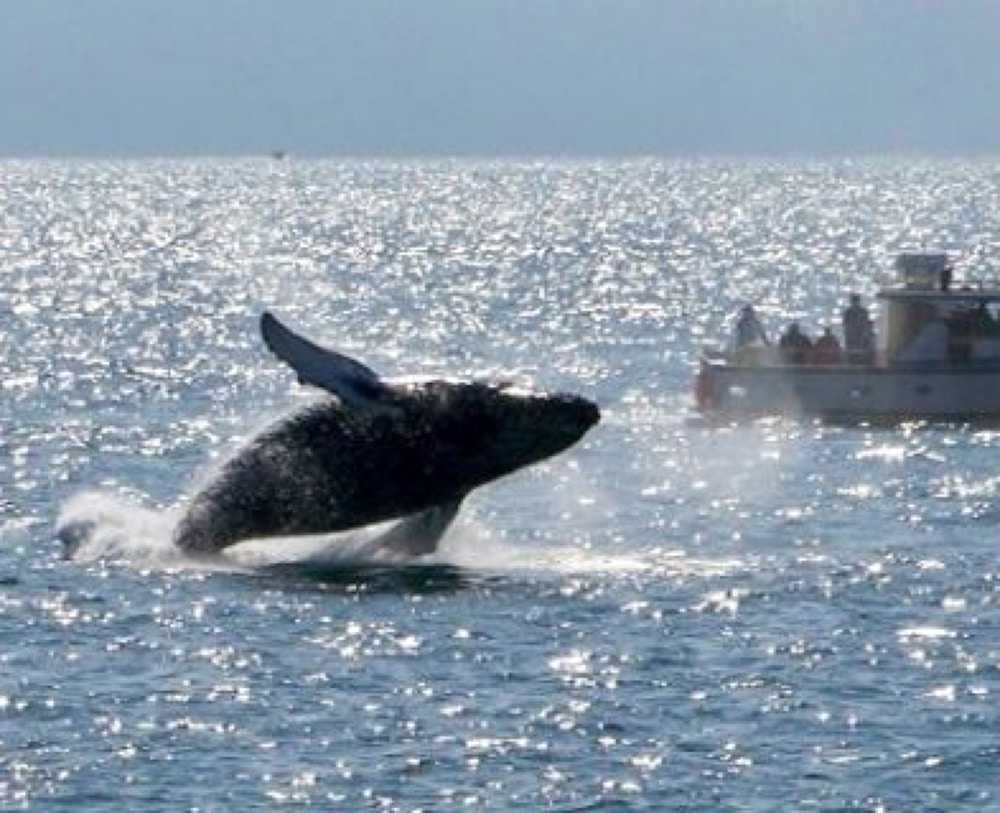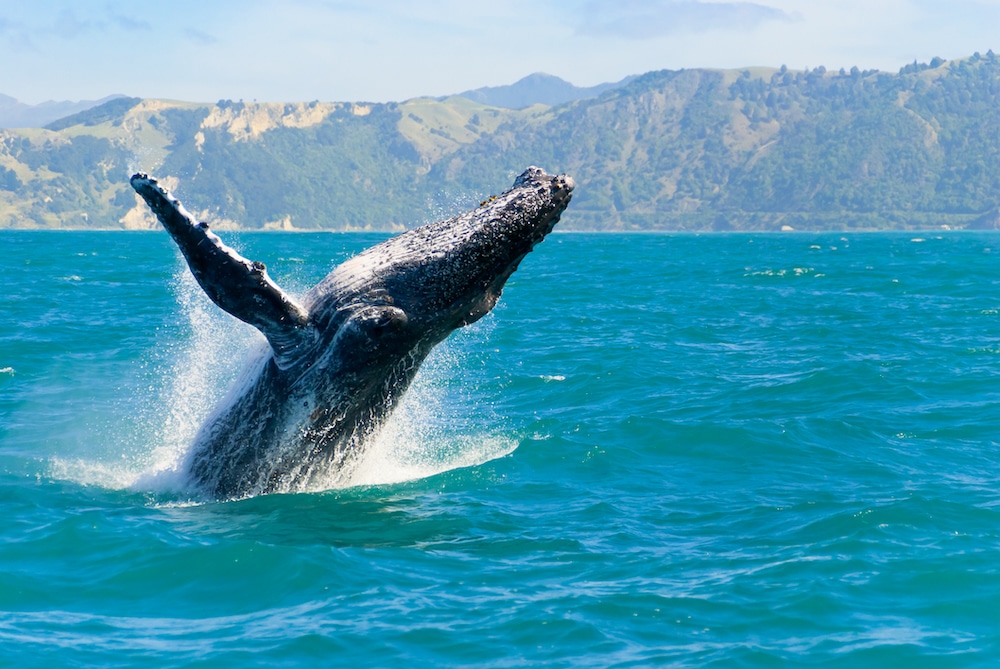4 of the Best Whale Watching Spots in the U.S.

 Why you can trust us
Why you can trust us
Founded in 2005 as an Ohio-based environmental newspaper, EcoWatch is a digital platform dedicated to publishing quality, science-based content on environmental issues, causes, and solutions.
Whale watching is a popular pastime and a great way to get outdoors, but not everyone knows the best places and times of year to see the largest mammals on Earth. Here’s a quick guide to some of the best places to catch a glimpse of these magnificent creatures in the United States.
San Juan Islands, Washington

Washington State — and the entire West Coast — has ample opportunities for whale watching. Specifically, the San Juan Islands off the Washington Coast is a great place to look for orcas, humpbacks, gray whales and minkes.
While some orcas, humpbacks and gray whales can be found year-round off the Washington Coast, the best time of year to see them is usually during the summer months. Southern resident orcas — who live in three pods, referred to as the J, K and L — typically make their way through the San Juans from May to October.
The picturesque archipelago is on the Whale Trail — a series of more than 100 sites with resources for watching whales and other marine life — like harbor seals, sea lions, marine birds and porpoises — from the shores of British Columbia down to Southern California.
“I used to go to summer camp in the San Juan Islands and sometimes we would go on boat trips. On one of these trips, one of my fellow campers yelled out, ‘Orcas!’ We all raced to the side of the boat to see a pod traveling besides us. The dark spears of their fins stood out against the gray waves and sky. We watched them arc up and down out of the water until our paths diverged. I was thrilled to see them; it felt like a gift from the universe. I felt honored that they chose to travel beside us,” Olivia Rosane, who is also the opinion editor for Common Dreams, told EcoWatch.
Seward, Alaska

Alaska is one of the best places in the world for wildlife viewing of any kind, including whales. Every year, more than 22,000 gray whales travel along the longest mammal migration route in the world — roughly 10,000 to 14,000 miles round-trip — from Baja, Mexico, north to where they feed in the Chukchi and Bering Seas. Gray whales migrate during the months of late February to May and generally stay near the coast, making them easier to spot — noninvasively — from shore.
During the warmer months — from May to August — you may also see humpback whales near Seward, as they return from their Hawaiian winter feeding grounds.
The best times to catch a glimpse of orcas in and around Resurrection Bay and Kenai Fjords National Park — where fin, minke and grays are also known to gather — is in May and June, though they are around all year.
“Orca whales don’t follow a migration pattern, and instead can be found where there is food, socialization, and ice coverage. Orcas, or killer whales, are the largest member of the dolphin family and have three main classifications: resident, transient, and offshore. We often spot resident orcas near Seward, as they feed on fish. Transient orcas can be spotted, but are less likely since they feed on marine mammals like seals,” Seward.com said.
After blue whales, fin whales are the largest mammals on Earth and are most often seen in Alaska from May to September, generally traveling by themselves or in smaller pods.
When you’re lucky enough to spot them, minke whales can also be seen from May to September, traveling in small, slow-moving pods.
Maui, Hawaii

The beautiful black and white humpback whale is one of the most majestic creatures on Earth. The weathered-looking cetacean can grow up to 60 feet in length and weigh as much as 80 thousand pounds. Most humpback populations were decimated by more than 95 percent before a final commercial whaling moratorium was imposed in 1985. There are now estimated to be approximately 84,000 mature humpback whales on Earth.
The powerful marine mammals — who live in all the world’s oceans — are increasing in much of their range, but are still threatened by entanglement in fishing gear, underwater noise pollution, vessel strikes and harassment from humans.
Humpback whale populations migrate along different routes. Hawaii’s Kohola — or Central North Pacific humpback whale population — travel back and forth from the Hawaiian Islands and Alaska.
The winter migration brings these gentle whales to Hawaii and the North Pacific Ocean from November to May each year, when more than 12,000 humpbacks come to the warmer waters to breed.
“We went to Maui in February about 7 years ago. When we got there we were told that it was prime whale watching time there on the island, so we booked a whale watching boat tour through the hotel. It was a small, modest boat with about 10 other people on it. We were all excited but skeptical about just how many whales we’d see since everyone knows that a lot of times whales can be elusive and unpredictable,” North Carolina resident Anna Moore Groome told EcoWatch. “It was a gorgeous sunny day and right from the beginning of the trip, we began seeing several whales. They were jumping and rolling, splashing their tails and fins and getting super close to our boat and snorting water all over us! We must have been right in the middle of a pod because there were large whales and small whales all around us. We stuck a microphone down in the water and heard what seemed like a million conversations going on under the surface. It was one of the most magical days of my life.”

Bar Harbor, Maine

A humpback whale in Bar Harbor, Maine. Patrick Hawks / CC BY-SA 2.0
The picturesque town of Bar Harbor, Maine, on Mount Desert Island is known as the gateway to Acadia National Park with its mountains, rocky cliffs, white sand beaches and sea views. Some of the wildlife living in Acadia National Park include bobcats, moose, porcupines, barred owls, beavers and American black bears.
Located along Frenchman Bay, the area offers wonderful opportunities for wildlife viewing and whale watching. The Shore Path begins at the town’s pier and meanders along the bay with views of the area’s islands.
The best time to see humpback whales, minkes and finbacks around Bar Harbor is from April to October, when the whales come to feed on krill, squid and fish in the Gulf of Maine.
“Our whale watching cruise from Bar Harbor was an adventurous way to rest between more strenuous hike days. We dressed in extra layers of clothing and brought warm hats and gloves, knowing the temperatures would drop once we ventured away from shore,” Michigan author Cynthia Birk told EcoWatch. “Although it took a little while to reach the area where the humpback whales were visible, we were entertained along the way with glimpses of dolphins racing alongside our boat. We also met majestic tall-masted schooners cruising in the opposite direction through the Gulf of Maine. It was too late in the season for us to see any puffins, but as we passed Mount Desert Rock, it looked as if every harbor seal in the area had decided to stop there to soak up the sun near the famous lighthouse. Our boat kept a respectful distance from the whales we encountered, but it was still close enough to see a thrilling show. We enjoyed observing their spouting and breaching behaviors and caught several slaps of tail flukes as the giant creatures dove into the ocean. It was a marvelous experience.”
Subscribe to get exclusive updates in our daily newsletter!
By signing up, you agree to the Terms of Use and Privacy Policy & to receive electronic communications from EcoWatch Media Group, which may include marketing promotions, advertisements and sponsored content.

 233k
233k  41k
41k  Subscribe
Subscribe 




